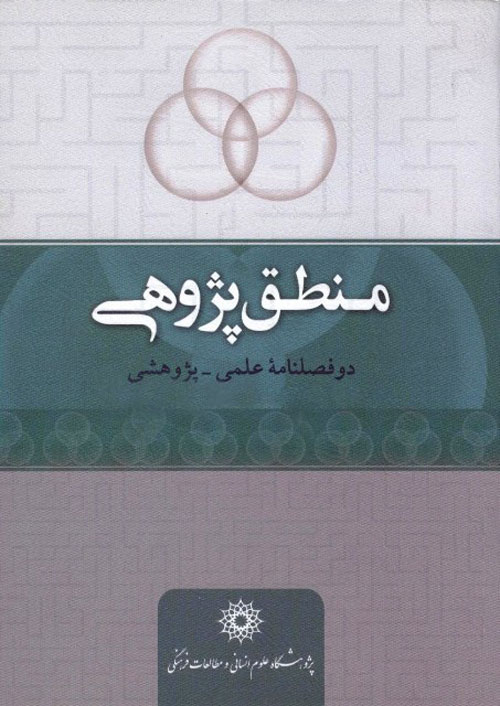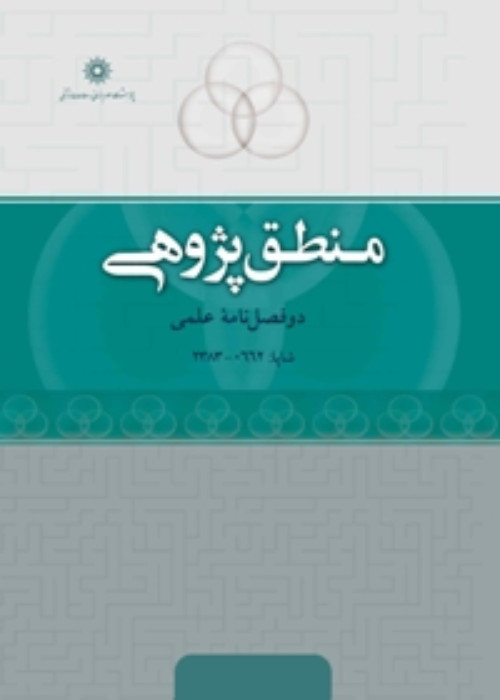فهرست مطالب

نشریه منطق پژوهی
سال ششم شماره 1 (بهار و تابستان 1394)
- تاریخ انتشار: 1394/07/18
- تعداد عناوین: 6
-
-
صفحات 1-19«منطق به صورت نامحدود... صوری نیست. اگر چنین بود، بدون محتوا می بود... هیچ علمی کاملا صوری نیست» (Frege، 1971:109).
در 1899، دیوید هیلبرت نظام اصل موضوعی منقحی برای هندسه اقلیدسی عرضه کرد و با اثبات مشروط فراقضیه های سازگاری و استقلال برای این نظام، راه حلی برای یکی از مسائل دیرپای ریاضیات (مشهور به مسئله خطوط موازی) ارائه داد. گوتلوب فرگه، پایه گذار منطق صوری جدید، مخالفت های بنیادینی با رویکرد فرمالیستی هیلبرت و برهان های او برای فراقضیه های سازگاری و استقلال ابراز داشت. بررسی دلایل این مخالفت نشان می دهد که دیدگاه فرگه نسبت به صوری بودن منطق و قضیه های فرانظریه ای به کلی متفاوت از دیدگاه پذیرفته شده امروزی است. در این مقاله پس از شرح مختصر روش اثبات هیلبرت برای فراقضیه های سازگاری و استقلال و همین طور انتقادهای اصلی فرگه به آن، به روش پیش نهادی خود فرگه برای پرداختن به این مسائل اشاره خواهم کرد و سپس به این بحث خواهم پرداخت که چرا در نهایت ریاضی دانان و منطق دانان، به پیروی از هیلبرت، به نکته سنجی های فرگه وقعی ننهادند و منطق جدید با معرفی نظریه مدل گام در راهی نهاد که از نگاه فرگه به هیچ وجه قابل قبول نبود. در پایان نتیجه ای که از این بررسی می گیرم این است که در واقع، فرگه و هیلبرت، هر یک بر اساس اندیشه ها و علایق خود، برداشت های متفاوتی از مفاهیمی مانند سازگاری و استقلال در دستگاه های اصل موضوعی داشته اند، جایی که فرگه به دنبال «سازگاری اندیشه ای» است هیلبرت صرفا «سازگاری نحوی» را اثبات می کند. برداشت سخت گیرانه فرگه از مفهوم سازگاری و استقلال دامنه پژوهش های بعدی را به شدت محدود می ساخت، حال آن که برداشت هیلبرتی امکانات وسیع و جذابی برای انجام بحث های فرانظریه ای فراهم می آورد.کلیدواژگان: دستگاه اصل موضوعی، فرانظریه، فراقضیه استقلال، فراقضیه سازگاری، تحلیل مفهومی -
صفحات 21-41در این مقاله ابتدا به معرفی اجمالی نظریه مطابقت و سپس اشکالات آن پرداخته ام و آن گاه نظریه صادق ساز را در پرتو نظریه مطابقت بررسی کرده ام. پس از معرفی این نظریه، به بحث چگونگی صدق گزاره های سالبه به واسطه اصل صادق ساز پرداخته ام و به انواع راه حل هایی که این نظریه برای پشتیبانی صدق گزاره های سالبه آورده است، اشاره کرده ام.کلیدواژگان: نظریه مطابقت صدق، اصل صادق ساز، گزاره سالبه، تمامیت وضع امور، ناسازگاری، فقدان
-
صفحات 43-71
مطابق دیدگاه اسمیت ارغنون کاربرد ویژه ای برای ارسطو دارد و آن اثبات این امر است که فلسفه اولی ممکن است. به نظر وی، انتظار اشتباهی است که هدف ارغنون را طرح نظریه های روش شناسی ارسطو تلقی کنیم. ارسطو در تحلیل دوم با ارائه استدلالی سعی می کند تا نشان دهد وجود یک معرفت غیربرهانی شرط کافی و لازم برای معرفت برهانی (علم) است. هدف معرفت غیربرهانی همان هدف فلسفه اولی، یعنی رسیدن به اصول اولیه هر علمی است. اسمیت بررسی می کند که استدلال مذکور در تحلیل دوم به سایر نظریه های منطقی ارسطو در ارغنون شامل نظریه های تعریف، حمل، دیالکتیک، مقولات و قیاس وابسته است. علاوه بر آن، ارسطو، در بخش پایانی تحلیل دوم امکان رسیدن به این معرفت غیربرهانی را با شرح فرایندی به نام نوس اثبات می کند.
کلیدواژگان: ارغنون، رابین اسمیت، منطق ارسطو، دیالکتیک ارسطو -
صفحات 73-93تعریف در منطق سنتی به حد و رسم تقسیم می شود و حد بنا بر دلایلی دور از دسترس دانسته می شود. بنابراین، آن چه مقدور است تعریف رسمی است. اما تبیین چیستی و شرایط رسم مشکلاتی را پدید آورده است. نتیجه این که رسم به سرنوشت حد گرفتار شده است و نشان داده می شود که فاقد ارزش منطقی و معرفت شناختی است. به نظر می رسد می توان در چهارچوب سنت منطق سینوی به بازسازی رسم پرداخت که لازمه اش بازنگری در تعریف و شرایط آن است. اگر چنین تلاشی موفق باشد معلوم می شود که نه رسم محدود به مرکب از ذاتیات و عرضیات است و نه عرضیات اختصاص به ماهیات مرکب دارد بلکه شامل ماهیات بسیط، عوارض وجودی و حتی عوارض تحلیلی هم می شود. بر این اساس، می توان اقسام قلمرو و کارکردهایی را برای رسم ترسیم و از ارزش منطقی و معرفت شناختی آن دفاع کرد تا آن جا که رسم می تواند همان کارکرد حد را داشته باشد بدون این که مشکلات آن را داشته باشد.کلیدواژگان: رسم، شرایط رسم، تعریف مفهومی، عوارض وجود، عوارض تحلیلی، منطق سینوی
-
صفحات 95-116بر اساس تفسیر مشهور، ارسطو در فصل چهارم «درباره عبارت»، گزاره را بر اساس صدق و کذب تعریف می کند. با این حال وی در پایان فصل پنجم، «بیان» دیگری را از گزاره «ساده» مطرح می کند. در این مقاله با توجه به فصل های چهارم و پنجم استدلال می شود که آن بیان دیگر، درواقع تعریف گزاره به صورت مطلق بر اساس تعلق گرفتن و تعلق نگرفتن، به عنوان مولفه هایی در حوزه واقعیت، است. برای این منظور ابتدا تفسیر برخی از مفسران از بخش پایانی فصل چهارم و فصل پنجم تقریر می شود. سپس نادرستی تعریف گزاره بر اساس صدق و کذب و ناسازگاری های این تفسیر با متن ارسطو مورد بررسی قرار می گیرد. آن گاه تفسیر پیش نهادی از متن ارسطو تقریر می شود و پس از اشاره به نحوه متفاوت تعریف مفاهیم تقسیم کننده نشان گرها، تعریف پیش نهادی از گزاره شرح داده می شود و به شباهت های این تفسیر با تفسیر فرفریوس اشاره می شود.کلیدواژگان: ارسطو، گزاره، درباره عبارت، مفسران ارسطو، صدق و کذب، تعلق گرفتن و تعلق نگرفتن
-
صفحات 117-141گنتزن قواعد سیستم منطقی را به دو دسته «قواعد عمل گری» و «قواعد ساختاری» تقسیم می کند. مقصود وی از قواعد عمل گری، قواعد معرفی و حذف یک ثابت منطقی است. قواعد ساختاری بیان کننده ویژگی های مبنایی یک استدلال است به گونه ای که هر تغییری در آن ها سبب تغییر کل سیستم می شود. وی در آثار خود به این نکته اشاره داشته است که معنای ثوابت منطقی صرفا از طریق قواعد عمل گری قابل حصول است این نکته زیربنای رویکرد استنتاج گرایی به معناداری ثوابت منطقی است. چرا قواعد عمل گری و ساختاری مجموعا به عنوان تعریف ثوابت منطقی لحاظ نشود؟! پیکاک با این پرسش مبنای رویکرد استنتاج گرایی را به چالش می کشد. ایان هکین در پاسخ به این ادعا، استدلال می کند که پذیرش ایده پیکاک، منجر به عدم پایستاری خواهد شد. در این مقاله پس از بررسی دقیق مفهوم قواعد ساختاری و بیان تمایز آن با قواعد عمل گری، استدلال هکین را ارزیابی و نقد خواهیم کرد و در نهایت راه کاری برای مسئله ارائه می شود.کلیدواژگان: استنتاج گرایی، تئوری برهان، ثوابت منطقی، قواعد عمل گری، قواعد ساختاری
-
Pages 1-19In 1899¡ David Hilbert offers an articulated axiomatic system for Euclidean geometry and¡ demonstrating conditionally the meta-theorems of compatibility and independence for this system¡ proposes a solution to one of the enduring problems of mathematics (known as the problem of parallel lines). Gottlob Frege¡ the founder of new formal logic¡ fundamentally disagreed with Hilberts formalistic approach and his proofs for the meta-theorems of compatibility and independence. The reasons for the opposition show that Frege''s view on formality of logic and meta-theorems of compatibility and independence is very different from today''s point of view. In this paper¡ after briefly discussing Hilberts method in demonstrating meta-theorems of compatibility and independence¡ and also the main Freges objections toward it¡ I will indicate to Freges own method dealing with these issues¡ and then discuss why eventually mathematicians and logicians¡ following Hilbert¡ ignored Freges remarks and modern logic¡ proposing a model theory¡ stepped on a road which was for Frege a wrong way.Keywords: axiomatic system, met, theory, meta, theorem of independence, meta, theorem of compatibility, conceptual analysis
-
Pages 21-41In this article, at first, I have explained correspondence theory of truth and I have dealt with its problems. Then I have explained the truth maker principle in the light of correspondence theory of truth. At the end, I have discussed how this theory can support negative proposition.Keywords: Correspondence theory of truth, Truth, maker principle, Negative proposition, Totality State of Affairs, Incompatibility, Absence
-
Pages 43-71
According to Smith, Organon for Aristotle is a special means to demonstrate that first philosophy is possible. For him, its incorrect to think that the aim of Organon is the introduction of Aristotles methodological theories. In Posterior Analytics, Aristotle by a demonstration tries to show that an undemonstrative knowledge is necessary and sufficient condition for demonstrative knowledge (episteme). The aim of undemonstrative knowledge is the aim of first philosophy, that is, coming to the first principles of any science. Smith considers the demonstration in question depends on other Aristotles logical theories in Organon involving theories of definition, predication, dialectic, categories, and deduction. Furthermore, in the last section of Posterior Analytic, Aristotle expressing a process called Nous shows that coming to the undemonstrative knowledge is possible.
Keywords: Organon, Robin Smith, Aristotle's logic, Aristotle's dialectic -
Pages 73-93In traditional logic, definitions are divided into essence oriented and accident oriented definitions, which the first one is considered inaccessible for some reasons and thus, the second is seen as the only feasible kind of definition. However explaining the nature and the conditions of the accident oriented definition has created some problems. As a result, accident oriented definition ended up with the fate of essence oriented definition and lost its logical and epistemological value. It seems that one might in the Avicenna's logic tradition reconstructs accident oriented definition, which of course requires reconsidering definition and its conditions.Keywords: accident oriented definition, essence oriented definition conceptual definition, Avicennian logic
-
Pages 95-116According to the common interpretation, Aristotle, in the fourth chapter of De Interpretatione, defines statement based on truth and falsehood. But in the end of the fifth chapter, he offers another account of simple statement. In this article, I will argue, that the account is in fact the definition of statement without qualification based on belonging and not belonging as elements of the realm of reality. Accordingly, the interpretations of commentators about the last part of the fourth and the fifth chapter will be presented. Then it is discussed that the definition of statement based on truth and falsehood is incorrect and has some incompatibilities with the Aristotle's text. After that, my interpretation of Aristotle's text will be explained and it is indicated that dividing concepts of signifiers is defined in a different manner. Finally, the chosen definition of statement and its similarities with Porphyry's interpretation are explained.Keywords: Aristotle, “De Interpretatione”, Statement, Aristotle's Commentators, truth, falsehood, belonging, not belonging
-
Pages 117-141Gentzen divides rules of logical system into operational rules and structural rules. By operational rules she means the rules of introduction and elimination of a logical constant. Structural rules represent the fundamental (structural) characteristics of an argument in such a way that any change in them causes changing in the whole system. In his works, Gentzen mentions that the meaning of logical constants can be achieved only through operational rules. This point is the infrastructure of inferentialism approach on meaningfulness of logical constants. Christopher Peacocke criticizes the basis of inferentialism approach. He believes that all structural and operational rules should be considered as the definition of logical constants. In response to this claim, Ian Hacking argued that accepting Peacocks idea, will lead to a lack of conservation. Lack of conservation causes system incompatibility. In this paper, after careful examination of structural rules and expressing its difference with operational rules, Hacking argument will be evaluated and criticized and finally a solution to the problem will be presented.Keywords: inferentialism, theory of proof, logical constants, operational rules, structural rules


